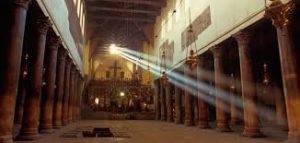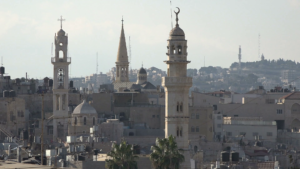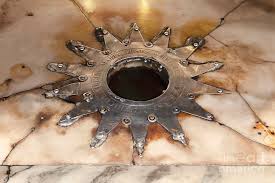Through this silver star pilgrims can look down into the cave where,
ever since the first century, Christians have believed Jesus was born.
By the summer of 1970, our time in Beirut had come to an end, and Israel was our first stop on the way back to the United States. (Because Arab countries would not accept passports stamped with the Israeli seal, if we had traveled to Israel while living in Lebanon we would not have been able to return to our home in Beirut.)
With our two little boys (no longer babies now, but 3 and 4 years old), we stayed for several nights in the hostel at St. George’s Cathedral in East Jerusalem. What the boys remembered of Jerusalem were the ducks on the grounds of St. George’s. (Each morning we were there, the Dean of the Cathedral would let the boys help him feed the ducks.)

St. Georges’ garden: Feeding the ducks
What we remembered were our day trips around the Holy Land, from Jerusalem to the Galilee to the Dead Sea, with a Palestinian Christian as our guide.
In old Jerusalem, we watched bulldozers knocking down Palestinian homes, to create easier access to the Western Wall (the “Wailing Wall”), the remnant of the great Temple of Jesus’ day.
Throughout the centuries, Jerusalem (which means “City of Peace” in Hebrew) has never really been at peace. Army after army has attacked its walls — and within those walls, thousands upon thousands of families have suffered and died.

Jerusalem: destruction of Palestinian homes
From Jerusalem our guide drove us the short distance to Bethlehem (which means “House of Bread” in Hebrew). Today a great wall divides old (and Palestinian) Bethlehem from newer (and Jewish) settlements on the West Bank of the Jordan River. But In 1970 the small town of Bethlehem was still completely open to the rocky hills surrounding it.
(Throughout the centuries, Bethlehem has always been a mostly Christian town. In 1967 — the year we went to Beirut — Bethlehem and the West Bank were still 86% Christian. But by 2017, the Christian population of the West Bank had dropped to 12% —and today’s Bethlehem has less than 11,000 Christians.)
In Bethlehem we entered the ancient church built over the traditional site of Jesus’ birth. Feeling our way through the church’s shadows, we found a silver star on the marble floor — and looked through the star into the even greater darkness of the cave below.

Bethlehem: Basilica of the Nativity
The cave beneath the silver star is the oldest of all Christian holy sites. In the early 4th century, a basilica was built over the cave; when that church was destroyed by war in the 7th century, another basilica was built upon the original foundation.
But the site of the silver star, while sanctified by the prayers of many pilgrims, left me cold. How I wished that I could have stood in the simple cave beneath, without the silver and gold accretions of the centuries!

Bethlehem in the late 20th century

